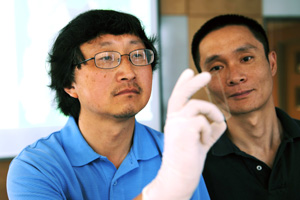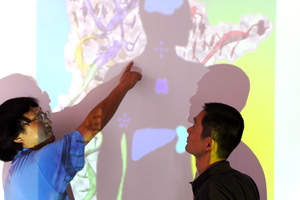Eureka moment
A chemist and a biologist investigate the possibility that a well-known genetic molecule serves another, unknown function.
By Benjamin Recchie, AB’03
Photography by by Dan Dry
Chuan He and Tao Pan have known each other for years. Both are faculty members at the University’s Institute for Biophysical Dynamics. Both have offices in the Gordon Center for Integrative Science: He on the east side with the chemists, and Pan on the west with the biologists. In fact, both study the same class of molecules—ribonucleic acid (RNA), used by cells to synthesize proteins. But it wasn’t until they attended a June 2008 breast-cancer conference in Washington that they thought about working together. A year-and-a-half later, their collaboration has yielded a new hypothesis that RNA might have a more important role in cells than previously suspected.

Tao Pan (left) and Chuan He examine a microscope slide of RNA. A molecular biologist and organic chemist, they are working together to understand how RNA regulates itself.
Back on campus, the two started talking. Pan, who earned his doctorate at Yale, recalls telling He, an MIT graduate, about a protein he was studying whose function he didn’t understand. Pan realized that perhaps He’s chemistry expertise could be valuable in unraveling the mystery. Figuring out the answer, the two say, could help illuminate the mechanisms that allow the growth of tumors.
The standard biological understanding of intracellular workings holds that cells regulate their activities by producing proteins. For instance, if a cell is stressed by the presence of a bacterium, it might produce a protein that serves as an antibacterial agent; a cell that detects a surplus of oxidizing chemicals might counter them by producing an antioxidant. When a cell needs to make a new protein, it turns to the blueprint contained in its DNA. The cell first creates a form of RNA, called messenger RNA, using the DNA as a template. It then forms a string of transfer RNA (tRNA), which actually assembles the protein it needs to make.
According to this theory, the RNA acts only as an intermediary between the DNA and the protein. But Pan, a tRNA expert, and He, who studies proteins and protein folding, believe that certain changes to the tRNA after it is produced might play a role in regulating cell functions, such as repairing damage or secreting an enzyme.

Pan and He discuss tRNA features that may play a role in cells’ response to stress.
Scientists have long known that cells self-regulate and respond to stresses by making different proteins. Scientists are also aware of the chemical modifications to tRNA, Pan explains, but there was only “circumstantial” evidence to believe the modifications were regulatory. If the changes to the RNA are reversible, then perhaps the cells use those modifications as another self-regulation mechanism.
“We’ve come up with the new idea that maybe those modifications aren’t permanent—that some of them can be removed under certain circumstances to allow the cell to adapt to stresses or different environments,” says Pan. Their project’s goal is to ascertain whether those modifications are in fact reversible, and, if so, to identify the enzymes and genes that carry it out. His lab has developed a microarray—a “lab on a chip” that can survey many RNA samples rapidly—that detects and quantifies changes in the tRNA structure. He’s lab, meanwhile, studies the chemical processes by which cells might make these tRNA modifications.
The concept is “out of nowhere,” says He, which made it a perfect candidate for the EUREKA grant it won this year from the National Institutes of Health. Started in 2007, the EUREKA program supports “exceptionally innovative research on novel hypotheses,” projects that have too high a failure risk to qualify for a grant through normal channels but that also have a high possible scientific payoff. The grant is worth $1.4 million over four years.
Researchers from He’s organic-chemistry group and Pan’s molecular-biology group have spent a lot of time in each other’s labs. The collaboration is made easier, both men say, by the Gordon Center’s design, meant to foster scientific cross-pollination. Pan and He plan to hire joint students in the future.
Understanding the role RNA plays in cellular self-regulation will offer insight into, among other illnesses, cancer. After all, says Pan, cancer is essentially a failure of cells to correctly self-regulate when a cell’s normal regulatory mechanisms break down and allow uncontrolled cell growth. A better idea of how that failure happens could lead to more effective treatments, not only for cancer but also for Alzheimer’s and other diseases.
